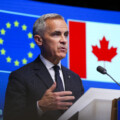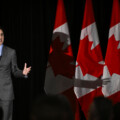With more than 100,000 Russian troops massing on the country’s eastern border, the eyes of the world are on Ukraine.
And although the West has been seized by debate about how to respond to potential Russian aggression, China is also closely following how the Ukrainian crisis plays out.
But what lesson will Beijing draw? On that, our foreign policy establishment is divided.
If Russian President Vladimir Putin gets a free pass into eastern Ukraine, even a “minor incursion,” will that embolden Beijing and encourage the Chinese government to make a similar threat to Taiwan?
Or conversely, would an all-out NATO effort to turn back Russian forces drain western resources and provide an opening for the Chinese in Taiwan?
It’s a vivid example of what New York Times columnist Ross Douthat described as a situation with no good answers, “only a least-bad balancing of options.”
It’s not hard to find experts promising imminent peril either way.
“Perhaps the best way to get China to attack Taiwan would be to use our limited military strength to double down in Europe,” wrote defence expert Elbridge Colby, who served as the deputy assistant Secretary of Defense for Strategy and Force Development in the Trump Administration
“Americans and our allies need to grapple with the reality: We don’t and won’t have a military big enough to increase commitments in Europe and have a chance of restoring our edge in Asia against China. We must prioritize,” wrote Colby.
Another former Trump administration official made the opposite case on Fox News on Friday.
“The Chinese are watching this very carefully. (Chinese president) Xi Jinping is watching every move Vladimir Putin takes and is considering that as he decides whether to invade Taiwan after the Olympics or not,” said former national security adviser Robert O’Brien
“We need to make sure that the idea that nation-states can invade their neighbors and take them over by conquest is not the new norm in international relations because it’s going to have consequences far beyond Ukraine,” said O’Brien.
However the U.S. chooses to respond, recent military maneuvers from both America and China show that both countries are keeping one eye on Taiwan while the crisis in Ukraine plays out.
On Sunday, both the Carl Vinson and Abraham Lincoln aircraft carriers began operations in the South China Sea near Taiwan. The same day, Beijing sent 34 fighters plus four electronic warfare aircraft and a single bomber into the Taiwanese air defence zone, the largest incursion since early October.
As the crisis in Ukraine unfolds, Prime Minister Justin Trudeau and his government are deliberating whether to send firearms and ammunition to the country. Canada has already committed to a $120 million loan to Ukraine.
A recent Abacus Data poll organized by the Ukrainian Canadian Congress found that 83 percent of Canadians were either in favour of or neutral to Canada assisting Ukraine to “protect its borders.” Three-quarters of Canadians say they support or could accept Canada sending weapons to Ukraine. The 2016 census found 1.4 million people of Ukrainian heritage in Canada.
The Abacus Data poll surveyed 1,000 Canadians and was conducted between Jan. 20-21.
A recent poll conducted in Ukraine found that close to 60 percent of Ukrainians want their country to join the European Union and NATO, which has been a flashpoint in the current crisis. At a recent press conference, U.S. President Joe Biden said one of Russian President Vladimir Putin’s demands is that Ukraine not be allowed to join NATO.
“We have a number of treaties internationally and in Europe that suggest that you get to choose who you want to be with. But the likelihood that Ukraine is going to join NATO in the near term is not very likely, based on much more work they have to do in terms of democracy and a few other things going on there, and whether or not the major allies in the West would vote to bring Ukraine in right now,” said Biden, at the freewheeling and surprisingly blunt press conference.
The sentiment across Europe is complicated, which Biden alluded to in his comments about the crisis.
A massive Pew Research poll conducted in 2020 across NATO member states and three non-members states, including Ukraine, found that NATO countries view the alliance favourably but are reluctant to fulfill the treaty’s “collective defence” obligations.
In fact, only five member states out of 16 show majority support for using military force to defend a NATO ally from an attack by Russia. Those countries are the Netherlands, the U.S., Canada, the U.K., and Lithuania.
In Germany, 60 percent of people said NATO should not use force to defend a member state against a hypothetical Russian attack and, in Italy, opposition reached 66 percent.
It reveals the tricky diplomatic situation for those who favour armed intervention against Russia, given that Ukraine isn’t even a member state of NATO and has no immediate likelihood of joining.
Whether or not the West intervenes to thwart Putin, some have argued that the dilemma posed by the crisis in Ukraine is itself an indictment of western military capacity.
“Though Russia poses an immediate threat to our partners and interests, Canada must be able to work with our allies to stand against both Moscow and Beijing’s belligerence simultaneously. They are part of the same authoritarian challenge to the rules-based international order; our attention should not be divided but united against this shared challenge,” wrote former defence minister Peter Mackay, in the National Post this week.
“That we lack the ability to confront both regimes simultaneously and strategically speaks to how atrophied our foreign affairs apparatus has become,” wrote Mackay.
Recommended for You

Michael Bonner: Are we witnessing the last gasp of Iran’s Islamic Republic?

Need to Know: Yahoo, Alberta! You’re doing something right

‘He’s a master of globalization in a re-nationalizing world’: Michael Ignatieff on the domestic and geopolitical challenges facing Prime Minister Carney

Peter Menzies: Justin Trudeau’s legislative legacy is still haunting the Liberals



